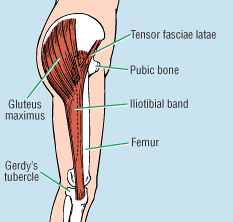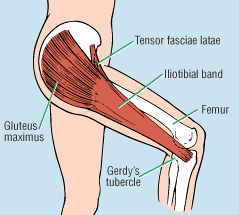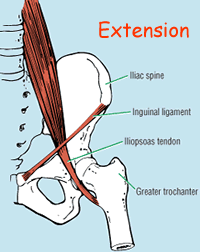Background
- Audible ‘snap’ around the hip on certain movements (often painless)
- Problematic in athletes (F>M particularly dancers)
- May become painful in more chronic cases
- Categorised as either ‘external’, ‘internal’ or intra-articular


External clicking hip
- Commonest cause of coxa saltans
- Thickened band of the iliotibial tract or gluteus maximus tendon slipping over the gr trochanter
- On hip flexion, the band moves anteriorly; then as gluteus maximus contracts, it is pulled posteriorly and snaps back across the greater trochanter
- Usually gradual onset months), mild discomfort (may be bilateral)
- Occasionally associated bursitis develops
- Patient can usually demonstrate click/snap
- Brignall test
- Patient lying on the unaffected side
- Pad under the buttock to keep affected hip in adduction
- Keeping the knee in extension, the hip is then actively flexed and extended
- Iliotibial band may be felt flicking over the greater trochanter
- With uncomplicated Hx / examination no investigations indicated
- Ask ED senior for advice if you are thinking of imaging


Internal clicking hip
- Usually iliopsoas tendon snapping over the iliopectineal eminence or femoral head
- Gradual onset (months)
- Must distinguish it from intra-articular causes for clicking and pain
- May be tenderness in adductor triangle
- Clinical Dx if snap can be triggered (see diagram)
- Iliopsoas snaps over femoral head when moving from flexion to extension (keep hip in external rotation during movement)
- Otherwise MRI
- Treat with physio (stretching)
- NSAIDs
Intra-articular causes
These include loose bodies, synovial chondromatosis, osteo-cartilaginous exostoses and acetabular labral tears. Keep a high index of suspicion.
- Acetabular tears most difficult to diagnose (even on MRI)
- Beware Perthe's disease (acetabular tears)
- Patient with intra articular causes may present with sudden traumatic trigger
- Pain is more prominent
- Beware if history of giving way
- Most have a history of limp at some time
- Limp is not a feature of extra-articular causes(not typically seen
- Beware pain on impingement during examination
- MRI imaging of choice
- Surgical management controversial
Management
- Conservative management, involving rest, NSAIDS and physiotherapy (mainly stretching exercises)
- There are a variety of surgical procedures available for refractory cases (refer to EM senior for advice)